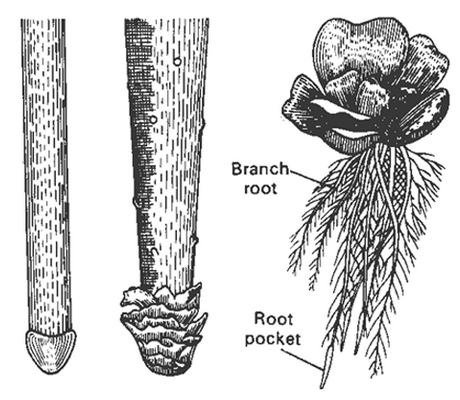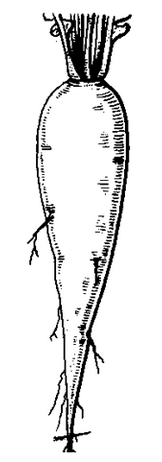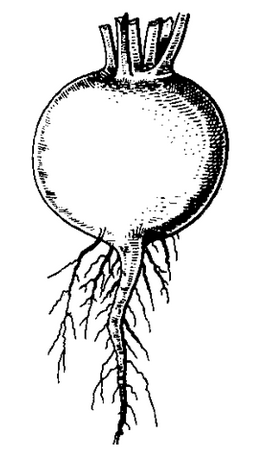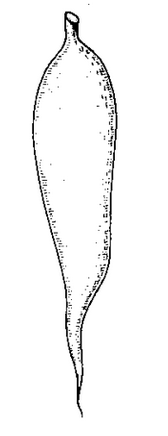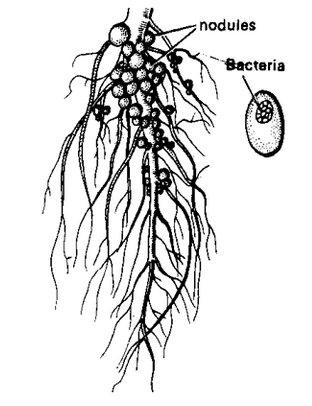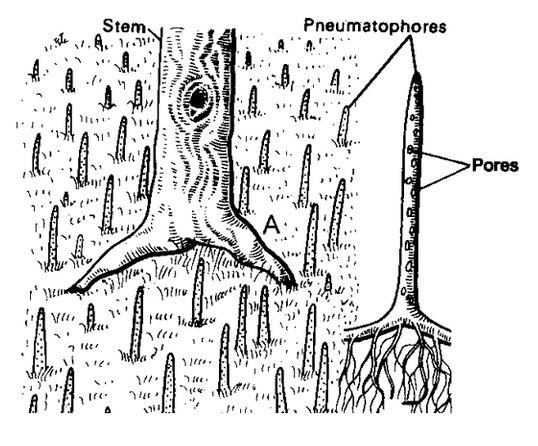Root
Morphology Of Angiosperm of Class 11
Root is an important vegetative part of the plant mainly responsible for nutrition and support. It is the descending organ of a plant originating from radicle of seed and growing towards centre of earth, away from sunlight.
CHARACTERISTICS OF ROOT
- Roots are positively geotropic, positively hydrotropic and negatively phototropic.
- They are colourless at young stage but become brown or deep brown on maturity.
|
Fig. Root cap ; Multiple root in Pandanus ; Root pocket in Pistia |
- Root bears unicellular root hair occurring in cluster for the absorption of water and minerals.
- Lateral roots are endogenous in origin.
REGIONS OF THE ROOT
- The root shows following four regions successively from the apex to base:
- Root cap region: The apical region of root is covered by a protective structure of thin walled cells known as root cap. The cells of root cap secrete mucilage which lubricates the soil through which the root is to grow. Root cap is the region of graviperception (Darwin and Darwin, 1880). An injured or broken root cap is replaced.
- Growing region: Just behind root cap, there is growing region. It is sub divided into two sub regions:
- Sub region of cell division: It is about 1mm in length. Here cells divide to produce new cells for the root cap and basal region of the root.
- Sub region of cell elongation: It lies behind the sub region of cell division and is about 4-8 mm in length. Here cells elongate rapidly and increase length of the root.
- Region of root hair: It is 1-6 cm in length. It consists of unicellular root hairs, which increase the exposed surface of the root for absorption. The growth of the root keeps the size of the root hair zone nearly constant, getting new cells from the zone of elongation and passing on its own older cells into mature or permanent region.
- Mature or permanent region: The cells of this region do not undergo any further change. i.e. differentiated into permanent tissues depending upon the functions they have to perform. In some cells special type of thickening develops. e.g., xylem tracheids and trachea. Lateral roots arise endogenously in an acropetal succession.
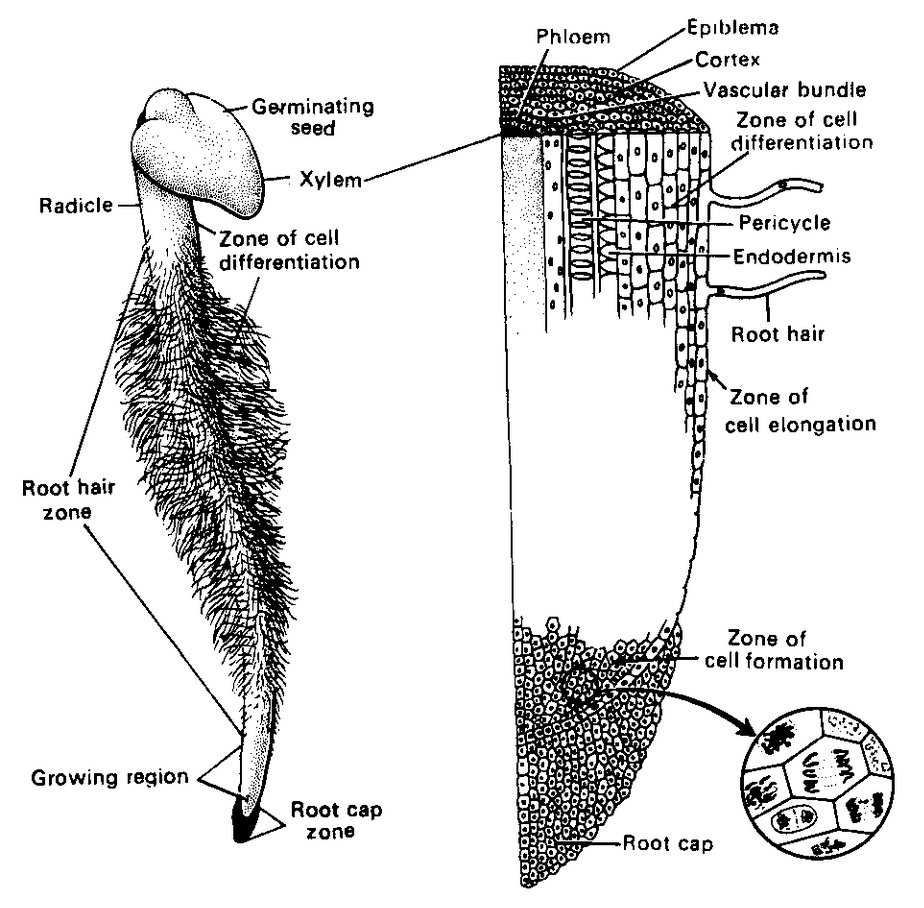
Fig. Regions of root
TYPES OF ROOTS
- On the basis of place of origin, there are two types of roots, normal and adventitious.
- Normal root: The root arising from the radicle of seed is called normal root. When a normal root becomes thick and persistent, then it is called tap root. It is deep feeder.
- Adventitious root: The root arising from any other part of plant, except radicle of seed is called adventitious root. It may arise from nodes, internodes, base of stem and leaves.
- In the members of family Poaceae (Gramineae), the normal root is of very short duration. It soon perishes down. From the base of stem many thin, fibrous roots arise. Such roots are surface feeders.
MODIFICATIONS OF TAP ROOT
- To perform functions other than normal, i.e., assimilation, storage of food, etc., tap root gets modified into following types:
- Fleshy tap root: Tap root with or without hypocotyl becomes swollen due to storage of food. The secondary roots borne over it remain thin. Such roots are of four types :
- Fusiform root: Such root becomes thicker in the middle and tapering on both ends. It assumes a spindle shape, e.g. radish (Raphanus sativus).
- Conical root: It is broad at the base and gradually tapers towards the apex giving it the shape of a cone, e.g., carrot (Daucus carota).
- Napiform root: It is swollen at the base and tapering abruptly in the apical region giving rise to a top-shaped structure. Here hypocotyl is large, e.g., turnip (Brassica rapa) and sugarbeet (Beta vulgaris).
- Tuberous root : It is swollen irregularly, e.g. 4 O’clock plant (Mirabilis jalapa).
|
Fusiform root |
Conical root |
Napiform root |
Tuberous root |
Fig. Tap root modifications
|
Fig. Nodulated roots of gram and nodule |
|
Fig. Respiratory roots |
- ReIproductive tap roots : n some plants, tap roots or their branches develop adventitious buds for formation of new plants, e.g., Dalbergia sissoo, Populus, etc.
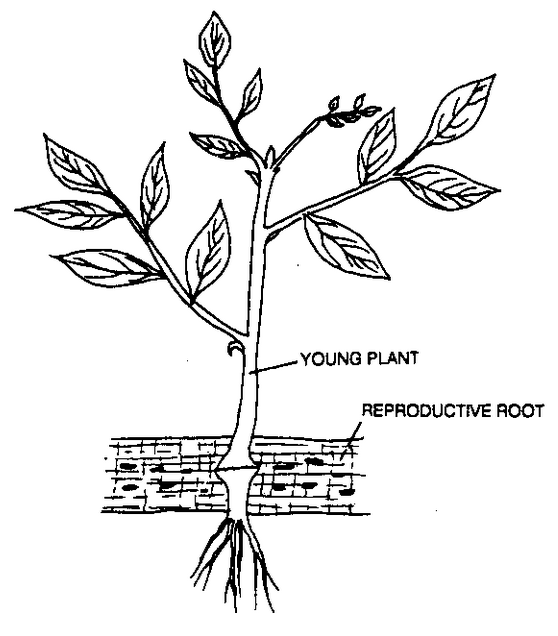
Fig. Reproductive roots of Dalbergia
MODIFICATIONS OF ADVENTITIOUS ROOTS
- To perform functions like storage of food, mechanical support and some special or vital functions, adventitious roots get modified into following types:
Modifications of Adventitious roots
|
Type |
Characteristics |
Examples |
For storage of food |
||
|
Tuberous roots |
A single indefinite shaped root arising from nodes of weak stem. |
Sweet potato (Ipomoea batatas) |
|
Fasciculated roots |
A cluster or fascicle of tuberous root. |
Dahlia, Ruellia, Asparagus etc. |
|
Beaded or Moniliform roots |
Root swollen at regular intervals like beads of a necklace. |
Portulaca, Indian spinach var, Kulfa (Basella rubra), bitter gourd (Momordica dioica). |
|
Nodulose roots |
Roots swell at their tips |
Mango ginger (Curcuma amada). |
|
Annulated roots |
A series of ring like swellings |
Ipecac (Cephaelis ipecacuanha). |
For mechanical support
|
Prop roots |
Pillar like root arising singly from one point of horizontally growing branches and growing vertically downward. |
Banyan (Ficus benghalensis), Indian rubber plant (F. elastica). |
|
Stilt roots |
Thin, thread like small roots growing obliquely from the basal nodes of the main stem. |
Maize (Zea mays), sugarcane (Saccharum officinarum), screwpine (Pandanus racemosus), etc. |
|
Climbing roots |
Thread like roots arising from nodes and internodes and surrounding the support. |
Betal (Piper betle), black pepper (Piper nigrum), money plant (Pothos aureus), poisonous ivy (Hedera helix), etc. |
|
Buttress roots |
Plate like roots arising from the base of tree trunk and spreading in different directions. |
Salmelia (Bombax cieba), old banyan tree, etc. |
|
Contractile roots |
Roots having wrinkles and can shrink. |
Saffron (Crocus), Zimikand (Amorphophallus sativus), etc. |
|
Floating roots |
Thick, spongy, fleshy roots with air filled air chambers arising from the nodes of stem. |
Jussiaea repens |
|
Leaf root |
Roots produced on the injured margin of leaves. |
Bryophyllum, Kalanchoe, Bignonia, etc. |
For vital functions
|
Epiphytic or hygroscopic roots |
A special kind of aerial root hanging freely in the air and possessing a covering of dead spongy tissue known as velamen to absorb moisture; having no root cap and root hair. |
Rasna (Vanda roxburghi), Dendrobium, etc. |
|
Assimilatory or photosynthetic roots |
Green roots capable of photosynthesis. |
Water chestnut (Trapa bispinosa), Gurcha (Tinospora sp.) etc. |
|
Parasitic roots |
Roots penetrating the host with the help of haustoria |
Dodder (Cuscuta reflexa) |
|
Mycorrhizal roots |
Roots associated with fungi |
Chir (Pinus), birch (Betula), etc. |
|
Root thorns |
Root modified into hard pointed structures |
Acanthorrhiza, Pothos, etc. |
|
Reproductive roots |
Roots bearing vegetative buds |
Trichosanthes, Ipomoea, etc. |

Tuberous rootsFasciculated rootsBeaded roots
(Ipomea batatus)(Dahlia)(Momordica dioica)

Nodulose rootsAnnulated rootsProp roots
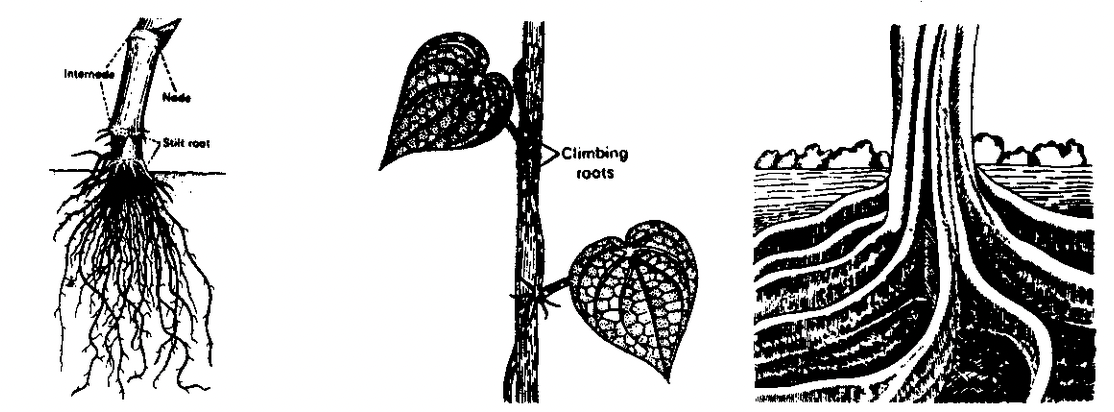
Stilt rootsClimbing rootsButtress roots

Epiphytic rootsAssimilatory rootsMycorrhizal roots
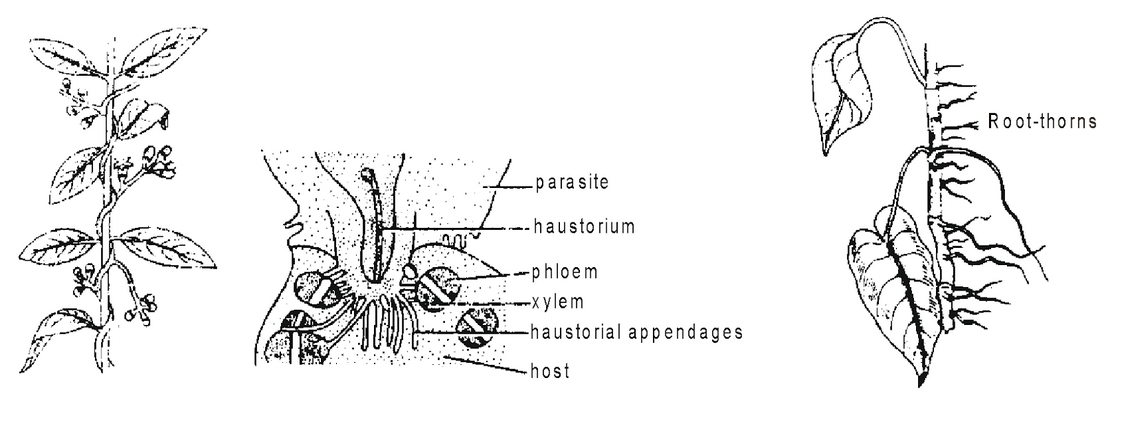
Parasitic roots Root thorns
Fig. Modifications of Adventitious roots
FUNCTIONS OF ROOTS
Normal functions
- Fixation: Root provides anchorage to the plants. It also provides mechanical support to the aerial parts against gravity and wind.
- Absorption: Roots absorb water and minerals from soil by its root hair.
- Conduction: It is also concerned with upward transport or conduction of water and minerals to the stem.
- Prevention of soil erosion: Roots hold the soil particles firmly to prevent soil erosion.
-
Accessory functions
- Storage: Fleshy roots store food materials.
- Mechanical support: Several types of modified adventitious roots provide mechanical support to the plants.
- N2-fixation: Nodulated roots of legumes fix nitrogen.
- Reproduction: Vegetative reproduction takes place by the radical buds.
- Photosynthesis: Assimilatory roots manufacture food.
- Balancing: Free floating plants are balanced in water by a cluster of adventitious roots.
- Aeration: Pneumatophores of mangrove plants help in respiration.
It is a mutually beneficial relationship of two organisms. It may be of following types:
- Mycorrhiza: It is the symbiotic association of fungi with roots of higher plants. The fungus absorbs water, salts and protects plants from soil borne pathogens. In return, it gets shelter and nourishment from the host. It is of two types:
- Ectomycorrhiza: In this case fungi occur outside the root of tree. The hyphae penetrate only between the outer cells and replace root hair, e.g., oak, birch pines, etc.
- Endomycorrhiza: In this case the fungi occur internal to the root tissue and their hyphae develop vesicles and arbuscules (fine branched masses) in the cortical cells. Therefore, it is also called VAM or vesicular arbuscular mycorrhiza, e.g., many orchids like Corallorhiza, Neottia, Epipogon, etc.
- Plants with root nodules: N2-fixing bacteria occur in root nodules of legumes, Alnus, Rubus, Casuarina, etc. The bacteria get shelter and food from the plant. In return, they provide the plant with a major portion of nitrogen fixed by them.
- Myrmicophily: It is the symbiotic relationship between ants and some higher plants. The ants obtain food and shelter from the plant. They protect the plant from other animals. Such association is best seen in Acacia sphaerocephala. In this case, the petiole of compound leaf is hollow and functions as ant shelter. Leaflet tips get modified into glands (Belt’s corpuscles), which possess feeding materials.
